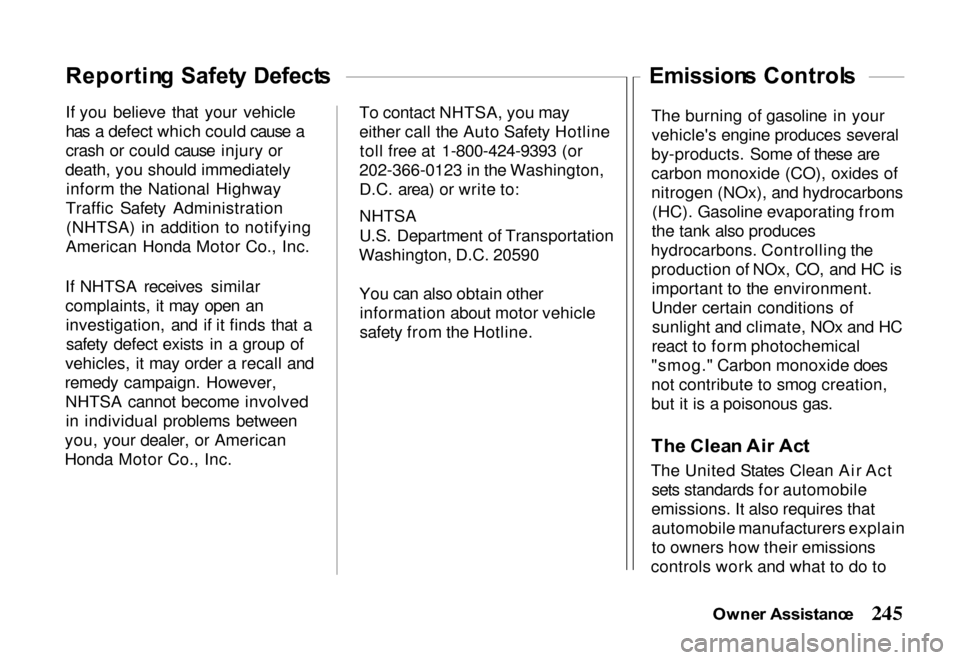2000 HONDA PASSPORT climate control
[x] Cancel search: climate controlPage 1 of 267

2000 Passport Online Reference Owner's Manual
Use these links (and links throughout this manual) to navigate through\
this reference.
For a printed owner's manual, click on authorized manuals or go to www.h\
elminc.com. Contents
Owner's Identification Form
A Word to the Owner
........................................................................\
................................................... i
Important Handling Information ........................................................................\
.............................. ii
A Few Words About Safety
........................................................................\
........................................ iv
Driver and Passenger Safety ........................................................................\
...................................... 3
Proper use and care of your vehicle's seat belts, and Supplemental Restr\
aint System.
Off to a Good Start
........................................................................\
..................................................... 47
Instruments and Controls
........................................................................\
......................................... 53
Instrument panel indicator and gauge, and how to use dashboard and steering co\
lumn controls.
Seats
........................................................................\
........................................................................\
.... 87
Interior Features
........................................................................\
....................................................... 95
Comfort and Convenience Features
........................................................................\
...................... 115
How to operate the climate control system, the audio system, and other c\
onvenience features.
Driving Tips
........................................................................\
.............................................................. 151
The proper way to start the engine, shift the transmission, and park, wh\
at gasoline to use, how to
break -in your new vehicle, and how to load luggage and other cargo.
In Case of Emergency
........................................................................\
.............................................. 179
This section covers several problems motorists sometimes experience, and how to handle them.
Care and Maintenance
........................................................................\
............................................ 191
The Maintenance Schedule shows you when you need to take your vehicle to\
the dealer and
tips on cleaning and protecting your vehicle. Things to look for if your\
car ever needs body
repairs.
Technical Data
........................................................................\
......................................................... 227
ID numbers, dimensions, capacities, and technical information.
Owner Assistance
........................................................................\
..................................................... 241
A summary of the warranties covering your new Honda, and how to contact \
us.
Authorized Manuals
........................................................................\
................................................ 249
How to order manuals and other technical literature.
Index ............................................................................................................................................... .....
251
Page 248 of 267

If you believe that your vehicle
has a defect which could cause a
crash or could cause injury or
death, you should immediately inform the National Highway
Traffic Safety Administration (NHTSA) in addition to notifying
American Honda Motor Co., Inc.
If NHTSA receives similar
complaints, it may open an investigation, and if it finds that asafety defect exists in a group of
vehicles, it may order a recall and
remedy campaign. However, NHTSA cannot become involvedin individual problems between
you, your dealer, or American
Honda Motor Co., Inc. To contact NHTSA, you may
either call the Auto Safety Hotline
toll free at 1-800-424-9393 (or
202-366-0123 in the Washington,
D.C. area) or write to:
NHTSA
U.S. Department of Transportation
Washington, D.C. 20590
You can also obtain otherinformation about motor vehicle
safety from the Hotline.
Emission
s Control s
The burning of gasoline in your vehicle's engine produces several
by-products. Some of these are
carbon monoxide (CO), oxides of
nitrogen (NOx), and hydrocarbons (HC). Gasoline evaporating from
the tank also produces
hydrocarbons. Controlling the production of NOx, CO, and HC isimportant to the environment.
Under certain conditions of sunlight and climate, NOx and HC
react to form photochemical
"smog." Carbon monoxide does
not contribute to smog creation,
but it is a poisonous gas.
Th e Clea n Ai r Ac t
The United States Clean Air Act sets standards for automobile
emissions. It also requires that automobile manufacturers explain
to owners how their emissions
controls work and what to do to
Owner Assistanc e
Reportin
g Safet y Defect s
Page 251 of 267

Treadwea
r
The treadwear grade is a comparative rating based on the
wear rate of the tire when tested
under controlled conditions on a specified government test course.
For example, a tire graded 150
would wear one-and-a-half (1-1/2) times as well on the
government course as a tire
graded 100. The relative
performance of tires depends upon the actual conditions of their
use, however, and may departsignificantly from the norm due to
variation in driving habits, service
practices and differences in road characteristics and climate.
Tractio n
The traction grades from highest
to lowest are AA, A, B, and C.
Those grades represent the tire's ability to stop on wet pavement as
measured under controlled
conditions on specified
government test surfaces of
asphalt and concrete. A tire
marked C may have poor traction
performance.
Warning: The traction grade assigned to this tire is based on
straight-ahead braking traction
tests, and does not include
acceleration, cornering,
hydroplaning, or peak traction
characteristics.
Temperatur e
The temperature grades are A (the highest), B and C, representing
the tire's resistance to the
generation of heat and its ability
to dissipate heat when tested
under controlled conditions on a specified indoor laboratory test
wheel. Sustained high temperature
can cause the material of the tire
to degenerate and reduce tire life and excessive temperature can
lead to sudden tire failure. The
grade C corresponds to a level of
performance which all vehicle tires must meet under the FederalMotor Vehicle Safety Standard
No. 109. Grades Band A
represent higher levels of
performance on the laboratory test wheel than the minimum required
by law.
Warning: The temperature grade for this tire is established for a tire
that is properly inflated and not overloaded. Excessive speed,
underinflation, or excessive
loading either separately or in
combination, can cause heat
build-up and possible tire failure.
Owne r Assistanc e